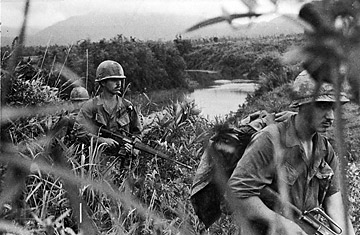
Almost 6,000 Army Reservists saw active duty in Vietnam.
Most Americans don't know there's an Army Reserve, and even many of those who do couldn't explain the difference between it and the active-duty Army. They're even more confused when it comes to distinguishing between the Army Reserve and the National Guard. So, here's all you really need to know about the Army Reserve: The Pentagon could not be fighting the wars in Afghanistan and Iraq without it. As the Army Reserve turns 100 years old April 23, it's worth noting just how much its mission has changed, and what that says about the way the nation is waging war.
The Army Reserve is made up of part-time soldiers, who for generations have undergone a period of full-time basic training, and then spent a weekend each month training and a week or two each year on extended exercises. (The National Guard is also a part-time force, whose members report to the governors of their states, but who can be "federalized" and sent off to war just like reservists).
During its first 80 years, the Army Reserve was deployed six times, a number it has eclipsed in the 20 years since. Nearly half of the Army's supporting units — everything from military police to civil-affairs units — now resides in the Army Reserve. Currently 26,000 of the Army's 190,000 Reservists are on active duty, including 6,600 in Iraq and 5,700 in Afghanistan.
After the Cold War, the Pentagon made dramatic cuts to its available ground forces, slicing the 770,000-strong active-duty Army to a complement of 479,000 on the eve of 9/11 (it's at 524,000 now). Dreams of waging future wars with $350 million F-22 fighters and $2 billion Virginia-class attack subs quickly evaporated as the mud-and-blood campaigns in Afghanistan and Iraq showed that the U.S. would need plenty of boots on the ground for years to come. That includes part-time boots — Army Reserve and National Guard units are now being cycled into Iraq and Afghanistan for repeated tours of a year or more.
"They're overusing the Reserves," says Lawrence Korb, who ran the Pentagon personnel shop during the Reagan Administration and now is a defense expert at the Center for American Progress. "They're no longer a strategic reserve, but an operational reserve." That gives the nation no cushion if a new war should break out tomorrow. And it gives military planners — trained to plan for worst-case scenarios — extended headaches.
Because of the dearth of active-duty soldiers (a shortage former Defense Secretary Donald Rumsfeld was loath to fix, although the Army is now rebuilding to 547,000 soldiers by 2010), the nation has had to rely more on the Reserves for deployment in Afghanistan and Iraq. That has made serving in the once laid-back Army Reserve not quite so laid-back, which has driven some soldiers out of the ranks. "We had a lot of trash we needed to clean out of the system," Lieutenant General Jack Stultz, chief of the Army Reserve, told Congress earlier this month. "Every day, almost, I sign papers discharging officers, lieutenants and captains who just refuse to participate."
Stultz, a former executive of Procter & Gamble, draws on his 25 years of selling soap to make serving in the reserves more attractive. "At Procter & Gamble we had a simple illustration we called a value equation — what does a box of Tide cost, and what do you get for it?" he told lawmakers. "And if you're going to increase the price of Tide, you'd better deliver something new and improved." That means the Pentagon needs to come up with better ways of attracting and keeping troops in its reserve force. "Now you're an operational force," Stultz said of his troops. "Now every four to five years, we're going to ask you to leave your family, leave your employer and risk your life." He wants to cut the reserves' retirement age from 60 to 55 to help make up for the new demands on them.
The Army Reserve came about as a way of avoiding the problems created by maintaining a large, full-time Army in peacetime. "Besides the genuine concern of political usurpation by a professional military force, the founding fathers realized that an Army primarily drawn from the general citizenry during times of national emergency also averted the possibility for unpopular wars," the Army Reserve's official history says. At age 100, then, it could be said to have accomplished half of its purpose.
